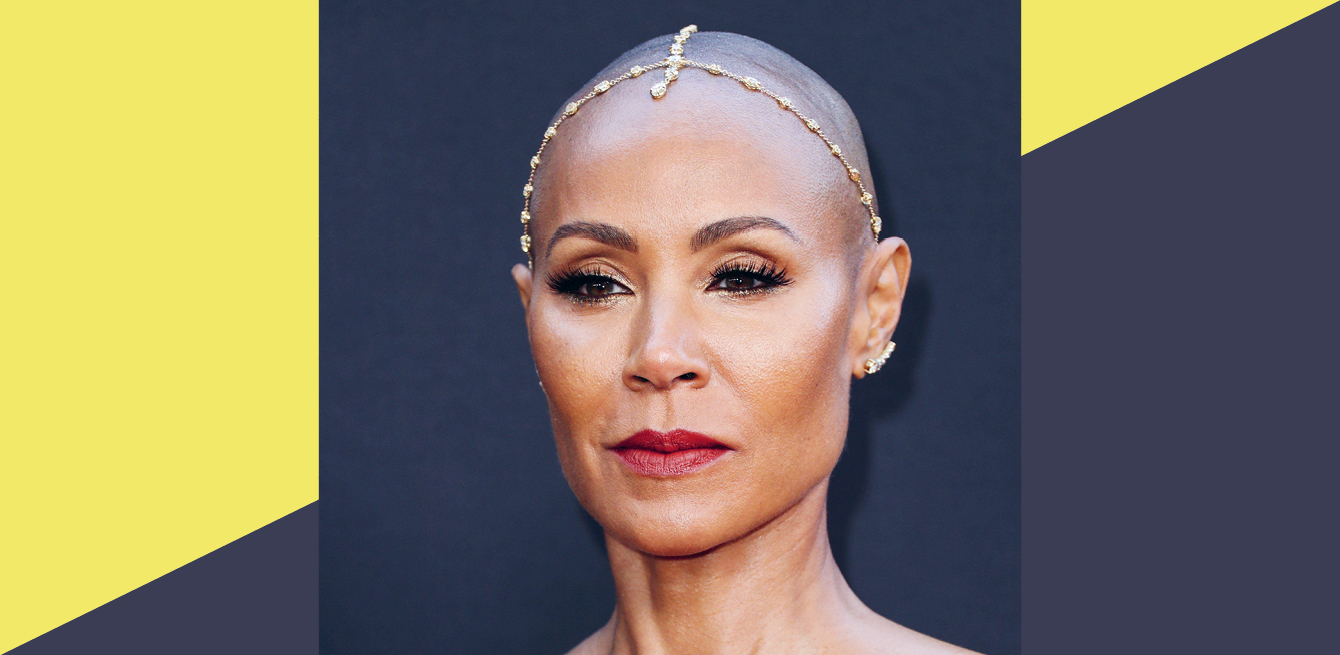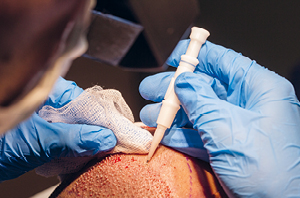
Alopecia is often experienced as a challenging condition. Solutions exist, but not many doctors are specialised enough.
Hair loss can induce anxiety. The official name of this very common dermatological disorder is alopecia. Consultant dermatologist at the University Hospital of Bern, Pierre de Viragh says that alopecia affects an estimated percentage of men that corresponds to their age group: 20% of men in their twenties, 30% in their thirties, and so on. Alopecia is generally considered a men’s health issue. But it can happen to women too. Particularly around the onset of menopause, the condition affects half of women.
The most common type is androgenetic alopecia and is hereditary. In these cases, hair follicles are genetically predisposed to be sensitive to dihydrotestosterone (DHT), a transformation of the male sex hormone testosterone. DHT therefore accelerates hair loss, until hair stops growing altogether. Alopecia causes hair to fall out in patches on the head. Hair at the back of the head, above the nape of the neck and around the ears is not affected because it is insensitive to hormones. These male sex hormones are also present in women, but in smaller amounts. Menopause causes hormonal changes, including the secretion of fewer hormones. The proportion of androgens is higher and can have an impact on hair follicles, especially if they are genetically predisposed to be sensitive to them.
In women, androgenetic alopecia is generally less visible and in a more diffuse pattern. Unlike men, women do not generally lose hair along the hairline.
This type of hair loss occurs faster and is generally more noticeable. Alopecia areata is characterised by the sudden loss of patches of hair with no obvious cause and can occur anywhere on the body. “I used to have very thick hair that never fell out. Then, overnight, I started losing tonnes of hair,” says Gregory, who got alopecia at the age of 27. “I’d leave some on the pillow, in the shower. I’d run my fingers through my hair and end up with a clump in my hand.” Blood tests didn’t detect anything, and his dermatologist attributed it to a stressful period he was going through. “As with migraines, we don’t really know what causes alopecia. So sometimes it’s associated with stress,” Pierre de Viragh says. Once the problem is resolved, the hair grows back. At first it’s white, but then it’s almost normal, although often not as thick.
Gregory’s hair has grown back, and his head hair and beard are now in black and white patches. “At first it was hard,” he says. “But then I got used to it, and now I like it. It gives me a unique style. It’s cool.”
There are other forms of alopecia, such as telogen effluvium, which causes a temporary, abundant hair loss, but “they’re much rarer,” Pierre de Viragh explains. They may be due to deficiencies or illness.
Although alopecia affects a large percentage of the population, few specialists are available in cantonal university hospitals in French-speaking Switzerland. Everyone interviewed went to general dermatologists for their hair loss problems. “Trichology is the scientific study of hair and scalp health and is widely overlooked around the world. And it’s not the most popular field in academic circles. It’s complicated to care for patients, and you gain little glory or scientific reputation from it.”
Fortunately, solutions exist. To start with, there are medications. For men, the main drugs are Minoxidil, which has a stimulating effect, “although we don’t understand the exact mechanism,” Pierre de Viragh admits, as well as Finasteride, which blocks the transformation of testosterone into DHT. Minoxidil also works for women, as do oral contraceptives with partial anti-androgenic activity.
“We get good results with lots of female patients.”
Multiple solutions are available in hair salons. “Some of them not very effective and can be a waste of time and money.” Light therapy? “There isn’t enough scientific data to support it.” Platelet-rich plasma injections? “It’s very expensive, it’s painful, and many experiments show that it’s effective only 50% of the time.” The expert believes you’re better off starting with other methods and keeping this alternative as a complementary treatment. “If a clinic offers you this type of injection as a first step, get out of there.”
Hair transplants are another effective way of combating hair loss. More and more people are having them. It’s a worldwide phenomenon. “Transplants have been on the rise in the last two or three years,” says Stéphane de Buren, a Swiss specialist who practises surgery outside Switzerland.
“It’s a snowball effect, because people realise that it works.”
And for this treatment, medical tourism is growing, especially to Turkey. “It’s comparable to what’s happening with plastic surgery and dental care. The Swiss go abroad for operations that are not covered by national health insurance.” For the same quality, prices are up to four times cheaper than in Switzerland, says Stéphane de Buren.
Several techniques are available for hair transplants. The best method, the expert says, involves removing hair follicles from areas not affected by alopecia, and implanting them in balding areas. This method is called “follicular unit extraction”. Another technique, called “follicular unit transplantation”, consists of removing entire strips of hair and extracting grafts from them.
While strip implantation is faster and less expensive, the surgeon recommends the first technique, which leaves no visible scar and is much less invasive. Doctors sometimes advise repeating the operation if hair loss continues. Before undergoing a transplant, Pierre de Viragh recommends medical treatment to stabilise situation.
“Transplants without treatment can produce poor long-term results. The hair at the back of the head is not of the same quality as hair at the front.”
Many so-called specialised institutes, both in Switzerland and abroad, are focused on the commercial aspect. “As soon as there’s no more business to do, they send patients to dermatologists.” He also recommends choosing the right type of centre. A good measure is to check whether the doctor in charge has his or her name on the door, guaranteeing that he or she personally takes responsibility for the facility. “Even if the operation is not very risky, it’s still surgery. It should be performed by someone with advanced training. And that costs money. “The best deal is not always the best choice.” /

To make up for the loss of hair, one technique involves removing hair from the back of the head before carefully transplanting it to the areas of hair loss. This method is called “follicular unit extraction”.
To increase hair density, sometimes in addition to a hair transplant, some choose tricopigmentation, a technique similar to a tattoo, but instead of implanting ink under the skin, bioabsorbable pigments are used to imitate hair.“It’s a fairly recent service in Switzerland but common Italy,” says Sandra Moscatello, a tricopigmentation specialist at a Geneva clinic. “Demand for it is growing.” Her clientele consists of people who are afraid of getting a transplant or want a complementary solution for an unsatisfactory transplant. "Most of my patients are men, because tricopigmentation can achieve a shaved head look,” she says. But I also have women, and the result is almost imperceptible, but it does give the impression of fuller hair.”
Actress, producer and director Jada Pinkett Smith inadvertently played a part in bringing alopecia to the public eye. She first openly discussed her diagnosis on television in 2018, but her condition became the subject of an online and media frenzy after the 2022 Academy Awards ceremony when her husband Will Smith slapped host Chris Rock for making a joke about her shaved look.